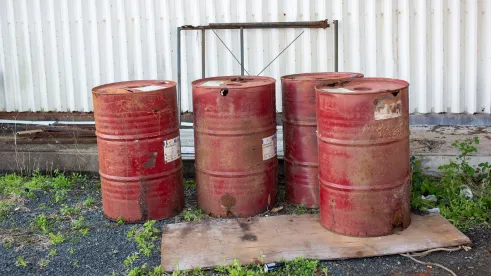This article was updated on October 26, 2021.
While it is nearly a year into the post-Brexit chemicals regulatory regime, the infrastructure to accommodate UK REACH registrations is not yet running smoothly and as a result importers and distributors of chemical substances are struggling to fulfill their obligations in time. For those companies that have not yet completed their registrations or notifications – and even for those companies that believe the necessary steps have been accomplished – updated functionality in the “Comply with UK REACH IT” platform and other developments make this an appropriate time to review their obligations for compliance purposes. Importers and distributors of chemicals from the EU into the UK must act now, as they have only a few days left in order to benefit from available transitional arrangements.
IN-DEPTH
Deadline for Submitting DUIN Notifications Is 27 October 2021
Prior to Brexit, companies based in the UK that sourced chemical substances from EU suppliers above one tonne per year were considered as downstream users and were not obliged to register. Under UK REACH, such UK entities are treated as importers. In order to be able to continue supplying the substances from the EU without having to register them until 27 October 2023, 2025 or 2027 (depending on the tonnage band and/or hazard profile of the substance), UK importers have to submit a Downstream User Import Notification (DUIN) to the UK Health and Safety Executive (HSE) by 27 October 2021.
The process is straightforward; only the following information needs to be emailed to UK HSE:
-
DUIN number, obtained by indicating on UK REACH IT that the company is an existing downstream user;
-
Legal entity name; and
-
Information on the substance(s) imported from the EU (i.e., substance name, CAS or EC number).
Unfortunately, DUIN submissions do not entitle a company to become a part of a “Substance Group”, an equivalent of EU SIEFs, and participate in data submission, cost sharing discussions or selection of a Lead Registrant. This is up to the new registrants and UK entities which have grandfathered their registrations. Additional guidance on notification of downstream user or distributor status can be found in our previous update on EU REACH registrations post-Brexit and HSE website.
It should be noted that DUIN notification is only available for established supply chains, where the downstream users sourced chemicals from an EU REACH registrant prior to Brexit. Therefore, DUIN notification is not possible where substances are sourced into the UK from outside the EU or where substances are imported into the UK for the first time.
In order to ensure uninterrupted supply, it is recommended that the UK entities further down the supply chain obtain confirmation that a DUIN for a specific substance they receive has been submitted Likewise. EU exporters into the UK need to confirm that substances sold are covered by UK REACH transitional provisions; otherwise registration will be required after 27 October in order to be able to place the substance on the UK market.
New Registrations: Article 26 Inquiry
As mentioned above, companies who were unable to grandfather their EU REACH registrations or cannot rely on DUINs will need to submit a new registration under UK REACH. The process is similar to that under EU REACH whereby the initial step is to submit an Article 26 inquiry and, at least theoretically, is fairly straightforward.
New registrants are required to prepare a IUCLID 6 dossier with basic information about the legal entity and substance they wish to register and upload it to UK REACH IT. The inquiry dossiers then proceed through two automated checks – Business Rules Check and Technical Completeness Check – and then a completeness check by HSE. Once all checks are passed, new registrants are added to the relevant Substance Group and can proceed to the full registration.
Article 26 inquiries do not entitle companies to import substances into the UK, and new registrants will need to submit their registration dossier containing information requirements relevant to their tonnage band as well as pay the required registration fee in order to be compliant with UK REACH. However, new registrants may be unable to fulfil the information requirements if the Lead Registrant has not yet been selected and the lead dossier submitted.
In such cases, once the Article 26 inquiry passes all the checks, HSE recommends that the company submits a IUCLID dossier which contains a waiver in Section 13.2 (NRES data waiver) with the following language: “The registrant is a New Registrant of an Existing Substance (NRES). Full study data is not yet available as the lead registration has not yet been submitted. The registrant agrees to make every effort to negotiate with the other members of the Substance Group and will subsequently either provide the data themselves as lead registrant, or will become a member of the joint registration.”
Companies should be aware that the verification process for Article 26 inquiries is not immediate. HSE has up to 10 working days to review inquiry dossiers; if there are any issues that may require the resubmission of the inquiry dossier then the process can become fairly lengthy. Numerous entities have had their Article 26 inquiries fail the completeness check due to how the substance identity and composition was recorded in EU REACH IUCLID files, possibly as analytical information is no longer considered adequate or because dossiers submitted under EU REACH are outdated. It is therefore essential that any company whose imports to the UK are not covered by a grandfathered registration or a DUIN starts the inquiry process immediately.
Lead Registrant Selection Functionality Now Available on REACH-IT
After some delay, UK REACH IT system has now been updated to allow companies in a Substance Group to identify the Lead Registrant.
Among other responsibilities, the Lead Registrant is tasked with submitting, via REACH IT, a lead joint registration dossier containing the relevant information under Article 11 UK REACH. As per above, theoretically, the same EU REACH dossier should suffice; however, it appears that completeness checks may pick up information gaps that were not an issue when the dossier was submitted with the European Chemicals Agency (ECHA). Therefore, Lead Registrants should plan their timing and effort to accommodate such issues. Following the submission of the dossier, the Lead Registrant will be responsible for approving membership in the joint registration group.
The Lead Registrant role can only be claimed after communicating such intention to the wider group and receiving approval from the co-registrants. HSE can remove the lead role if these requirements are not met. Should disputes arise with respect to which entity should act as the Lead Registrant—if, for example, there is disagreement about who should be the Lead Registrant, or if co-registrants feel that the Lead Registrant is not performing their duties as required—Substance Group participants are requested to resolve the dispute among themselves. Failing that, appropriate evidence should be presented to HSE for resolution. It is yet unclear how such disputes would be facilitated by HSE or what information would be sufficient to remove a Lead Registrant.
Lastly, it should be noted that Article 26 inquirers will not be able to claim the Lead Registrant status until their registration dossier has been submitted and accepted by HSE as well as registration fee is paid.
Challenges Remain for UK Importers, Manufacturers and Traders
As REACH obligations start coming into force, issues and concerns faced by industry inevitably continue to increase and include, among others:
Difficulties in communicating with HSE. As the regulator taking over the role of ECHA in the UK, HSE now has significant additional responsibilities. However, due to the number of inquiries HSE receives, some companies are encountering issues when trying to obtain guidance. In particular, we note that the HSE telephone helpline can only assist with queries on the functionalities of UK REACH IT, but it cannot actually assist with significant technical issues companies might encounter. HSE also set up an email contact for all UK REACH queries (ukreach.clp@hse.gov.uk); however, it may take up to 10 working days to receive a response. There are also different teams in charge of the telephone helpline and email contact, which may further complicate communications. In light of the above, companies should plan ahead and set aside additional time as communications with HSE may take longer than expected.
Registration costs may complicate relationships between buyers and sellers. Registration fees are based on UK importers’ or distributors’ annual volume and can range from about £2,000 to £28,000 per chemical. While some non-UK suppliers are registering the chemicals they deliver to UK end-users (via UK entities or only representatives), others are not providing this service, shifting responsibility and costs to end-users.
Costs and competitor non-compliance may shake up markets. HSE has been taking a pragmatic approach to enforcement in light of the challenges faced by companies adapting to the post-Brexit regulatory landscape. Companies that are fulfilling their obligations have expressed concerns that other importers’ non-compliance with UK REACH registration requirements may give the latter an unfair competitive advantage. On the other hand, some importers and distributors see potential opportunities to increase market share should other companies determine that the costs associated with registration outweigh predicted profitability.
Additional costs for data. Companies should not forget that their contractual arrangements may not entitle them to transfer or access data on the main registration dossiers on EU REACH IT for the purpose of complying with UK REACH. Most Lead Registrants and EU REACH consortia are taking a sensible approach and only charging companies nominal fees to extend the rights to use existing data for UK REACH purposes. However, this is not always the case, and some companies may be requested to pay additional amounts for the rights to use data for UK REACH registrations.
Supply-chain disruptions are adding pressure to chemical companies. As the UK’s dependence on imports of base oils, lubricants, chemicals and other products subject to UK REACH continues to grow, post-Brexit supply chain issues are in turn having a greater impact. Transport shortages increased distribution costs and other uncertainties are likely to persist well into 2022. These uncertainties add to the financial calculus required of UK-based downstream users.
Key Takeaways
Businesses working with chemical substances in the UK market should take the following steps:
-
Gain a full understanding of the chemicals being imported or distributed (or for which there are plans to import or distribute) and how they are affected by UK REACH.
-
Clarify the company’s position in the supply chain and obtain necessary confirmations on who is taking responsibility for UK REACH compliance.
-
If a UK-based downstream user or importer, complete the DUIN registration on REACH IT by 27 October 2021.
-
Work with vendors, suppliers and others to negotiate payment of registration fees and any cost-sharing arrangements.
-
Work with suppliers and customers to identify and resolve potential supply chain and distribution issues arising out of broader post-Brexit economic, transportation and related uncertainties.
-
Seek qualified legal counsel if you have any questions regarding compliance with UK REACH and its impact on your company’s operations and business relationships, especially if you missed essential regulatory deadlines.
The UK REACH regime continues to evolve, and its provisions and deadlines are subject to change.





 />i
/>i

